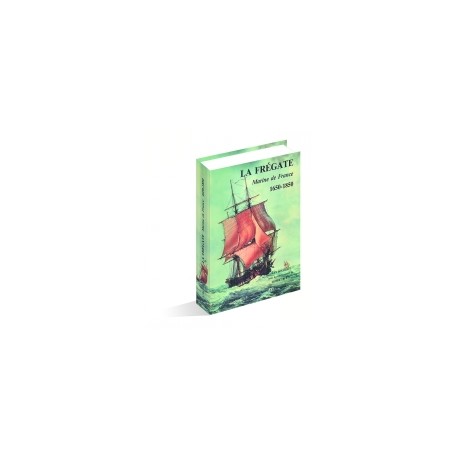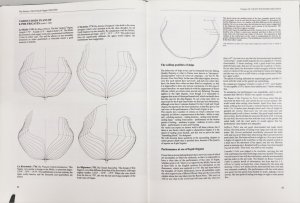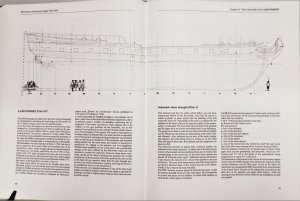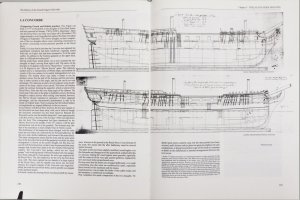Book Review:
THE HISTORY OF THE FRENCH FRIGATE 1650-1850
by Jean Boudriot & Hubert Berti
translated by David H. Roberts
actual title of revised copy
FRIGATES IN THE FRENCH NAVY 1650 - 1850
AN HISTORICAL STUDY OF THE FRIGATE IN THE FRENCH NAVY
original french title:
La FREGATE Marine de France 1650-1850


The book is available at ancre in the original french language, but also in english and since short time in italian language - with order you can choose the requested language.
My copy, I introduce is the english version, with translation by David H. Rogers.

 ancre.fr
ancre.fr
SYNOPSIS at ancre:
This book is devoted to the history of a ship whose very name evokes deep historical resonances, the frigate. The reader follows the evolution of frigates in the French navy from their origin in the 1660s to the mid-19th century when the sailing wood military navy reached an end.
The evolution of frigates may be divided into two phases. The first phase is characterized by the use of small two-decker vessels and of modest ships called light frigates. This period ended around 1750 when small vessels were no longer used, to the "benefit" of the frigate. No longer qualified as "light", frigates then gained characteristics and qualities that were to transform them into "modern frigates", with guns and dimensions that increased constantly in this second phase.
This historical study begins with a general orientation presenting an overview of subsequent chapters. Each chapter deals with a specific class of frigates, characterized by the caliber of their guns. Each chapter opens with a text that historically and technically locates the main characteristics of the class of frigate presented in the chapter. Guided by this over arching presentation, the reader can then proceed easily through the various plans, diagrams, tables, commentaries and notes relating to the study of each class.
The following chapter gathers general and comparative data whose collective elements give an overall evaluation of previous chapters, thanks to numerous sketches, graphs and tables which sometimes analyze frigates in relation to other vessels. The chapter ends with a recapitulation that summarizes the designation and main characteristics of 600 frigates in the French Navy.
The following chapter deals with all aspects of the evolution of frigates: accommodations, guns, decorations, masts and spars, sails, etc. over two centuries.
The final chapter gathers nearly 70 photos of ship models belonging to the collections of the Musée de la Marine.
The original period documents reproduced and gathered in this book constitute a corpus that is without equal. This study is unprecedented in the history of French naval architecture.
Illustrations are abundant, with 106 plans of ships, 92 reproductions of documents of the time, 68 photos and 48 statements, numerical tables, graphs and indexes. In short, this book is a genuine encyclopedia of frigates.




SYNOPSIS inside the book:
The frigate is perhaps the most romantic of all warships from the great age of sail. Fast and yet extremely powerful for its size, able to keep the sea in all weathers, the frigate was a redoubtable adversary. Its sleek lines made it a favourite subject of marine painters and engravers, and its tactical role ensured that it was in action much more frequently than the larger ships of the line, such that the names of frigate captains are often better-known than those of the Admirals of the period: Suffren, Cochrane and Pellew, Manley and Preble, to name but a few.
However, in frigates perhaps more than in any other type of vessel, the actions of the commanders are inseparable from the technology at their command: arguably, the true victor is the frigate, a complex machine of wood, canvas and cordage, a floating gun-platform, harnessed to a tactical purpose. And it is this machine, rather than the men who commanded, which forms the subject of this book. The “modern” frigate, of the type introduced into all the major navies of the 18"‘ century, was a French development, so that the history of the French frigate is an essential adjunct to the study of the frigate of any of the world’s navies.
While much has been written about the less glamorous work-horse of the Navy, the ship of the line, surprisingly little has appeared in print on the subject of the frigate. This is the first book in any language to attempt to tell the whole story of its development. Jean Boudriot is uniquely qualified to tell that story. His Collection Archéologie Navale Francaise now extends to over twenty volumes, and, to use the words of a recent reviewer, “the whole is a contribution to maritime history unequalled by any other scholar, or any other country".
The French frigate has already been the subject of three monographs in the series, with La Renommée (8-pdr, 1744), La Belle-Paul: (l2-pdr, I765), and La Vénus (l 8-pdr, I782), but this book is entirely new: it follows the evolution of the sailing frigate in the French Navy from its earliest beginnings to the advent of steam. Each type is covered in a separate chapter: the light cruisers of the 17th century, the 8-pdr class of the 1740s and 1750s, the l2-pdrs of the Seven Years’ War and afier, the much-admired 18-pdrs of the Revolutionary and Napoleonic Wars, and the 24- and 30-pdr frigates of the 19"‘ century. The final chapter investigates all aspects of their evolution, with major sections on French sea ordnance, internal arrangements, masting and rigging, sails, carved-work and decoration, as well as a thorough review of the magnificent collection of frigate models in the Musée de la Marine in Paris. Profusely illustrated like all Jean Boudriot‘s books, no major documentary source in the French archives has been neglected, with much else culled from the collections of the National Maritime Museum in Greenwich and the Danish National Archives in Copenhagen: a significant proportion of these documents are reproduced or quoted from at length. They are enriched by a selection of Jean Boudriot’s own meticulous plans from the monographs, reproduced at a smaller scale in three additional chapters, so that this book forms a companion volume to the four volumes of The Seyenty-Four Gun Ship, and to the three monographs shortly to be published in English.
For anyone who wishes to understand the complex technology of the frigate, and the various stages of its development, this book is essential reading: historians and model makers, enthusiasts of the sea novel or the armchair sailor, all will find much which is new and fascinating .
For those who would like to make a model of any of the three frigates covered extensively in this book, sets of plans at a much larger scale will shortly be available separately




CONTENTS:
The content list on the web-page from ancre differs to the contents list inside the book, so it could be that it was changed with the second edition. Also my copy has more than 400 pages, but the web-page is telling us about 350 pages.
I will clarify this with Didier Berti from ancre in short time.
I assume, that I have an older edition which was revised later on
from the web-page (actual content)
General remarks
Chapter I - The Frigate-Vessels, 1640-1756
Chapter II - The Light Frigates, 1659-1744
Chapter III - The 8-pdr Frigates, 1740-1774
Chapter IV - The 12-pdr Frigates, 1748-1798
Chapter V - The 18-pdr Frigates, 1781-1813
Chapter VI - The 24-pdr Frigates, 1772-1843
Chapter VII - The 30-pdr Frigates, 1805-1846
Chapter VIII - Comparative and General Data
Chapter IX - Aspects of Development
Collection of photographs of ship models.

from the book (earlier content)
General consideration
Chapter I - Ship frigates
Chapter II - Light frigates
Chapter III - 8-pounder frigates
Chapter IV - La Renommee
Chapter V - 12-pounder frigates
Hull protection
Chapter VI - La Belle-Poule
Chapter VII - 18-pounder frigates
Chapter VIII - La Venus
Chapter IX - 24-pounder frigates
Chapter X - 30-pounder frigates
Chapter XI - Comparative tables
Chapter XII - A study in evolution
Internal arrangements
Armament
Carved work and decoration
Masts and spars
Sails
Other innovations 1820 - 1840
Photographs of frigate models
Alphabetical list of frigates, 1650 - 1850
General Index






COMMENT:
in my opinion it is a must-have book, if you highly interested in the development of french frigates over the most important time period of 200 years. Very good especially are the comparison of the different body plans. This book is highly recommended...... I will study it once more, in order to help me in my decision, which frigate would be the next on my work-bench.
To be continued ..... take a look at the next post in this thread ......
THE HISTORY OF THE FRENCH FRIGATE 1650-1850
by Jean Boudriot & Hubert Berti
translated by David H. Roberts
actual title of revised copy
FRIGATES IN THE FRENCH NAVY 1650 - 1850
AN HISTORICAL STUDY OF THE FRIGATE IN THE FRENCH NAVY
original french title:
La FREGATE Marine de France 1650-1850


The book is available at ancre in the original french language, but also in english and since short time in italian language - with order you can choose the requested language.
My copy, I introduce is the english version, with translation by David H. Rogers.

FREGATE Marine de France 1650-1850 - Ancre
FRIGATES IN THE FRENCH NAVY 1650 - 1850 AN HISTORICAL STUDY OF THE FRIGATE IN THE FRENCH NAVY
SYNOPSIS at ancre:
This book is devoted to the history of a ship whose very name evokes deep historical resonances, the frigate. The reader follows the evolution of frigates in the French navy from their origin in the 1660s to the mid-19th century when the sailing wood military navy reached an end.
The evolution of frigates may be divided into two phases. The first phase is characterized by the use of small two-decker vessels and of modest ships called light frigates. This period ended around 1750 when small vessels were no longer used, to the "benefit" of the frigate. No longer qualified as "light", frigates then gained characteristics and qualities that were to transform them into "modern frigates", with guns and dimensions that increased constantly in this second phase.
This historical study begins with a general orientation presenting an overview of subsequent chapters. Each chapter deals with a specific class of frigates, characterized by the caliber of their guns. Each chapter opens with a text that historically and technically locates the main characteristics of the class of frigate presented in the chapter. Guided by this over arching presentation, the reader can then proceed easily through the various plans, diagrams, tables, commentaries and notes relating to the study of each class.
The following chapter gathers general and comparative data whose collective elements give an overall evaluation of previous chapters, thanks to numerous sketches, graphs and tables which sometimes analyze frigates in relation to other vessels. The chapter ends with a recapitulation that summarizes the designation and main characteristics of 600 frigates in the French Navy.
The following chapter deals with all aspects of the evolution of frigates: accommodations, guns, decorations, masts and spars, sails, etc. over two centuries.
The final chapter gathers nearly 70 photos of ship models belonging to the collections of the Musée de la Marine.
The original period documents reproduced and gathered in this book constitute a corpus that is without equal. This study is unprecedented in the history of French naval architecture.
Illustrations are abundant, with 106 plans of ships, 92 reproductions of documents of the time, 68 photos and 48 statements, numerical tables, graphs and indexes. In short, this book is a genuine encyclopedia of frigates.




SYNOPSIS inside the book:
The frigate is perhaps the most romantic of all warships from the great age of sail. Fast and yet extremely powerful for its size, able to keep the sea in all weathers, the frigate was a redoubtable adversary. Its sleek lines made it a favourite subject of marine painters and engravers, and its tactical role ensured that it was in action much more frequently than the larger ships of the line, such that the names of frigate captains are often better-known than those of the Admirals of the period: Suffren, Cochrane and Pellew, Manley and Preble, to name but a few.
However, in frigates perhaps more than in any other type of vessel, the actions of the commanders are inseparable from the technology at their command: arguably, the true victor is the frigate, a complex machine of wood, canvas and cordage, a floating gun-platform, harnessed to a tactical purpose. And it is this machine, rather than the men who commanded, which forms the subject of this book. The “modern” frigate, of the type introduced into all the major navies of the 18"‘ century, was a French development, so that the history of the French frigate is an essential adjunct to the study of the frigate of any of the world’s navies.
While much has been written about the less glamorous work-horse of the Navy, the ship of the line, surprisingly little has appeared in print on the subject of the frigate. This is the first book in any language to attempt to tell the whole story of its development. Jean Boudriot is uniquely qualified to tell that story. His Collection Archéologie Navale Francaise now extends to over twenty volumes, and, to use the words of a recent reviewer, “the whole is a contribution to maritime history unequalled by any other scholar, or any other country".
The French frigate has already been the subject of three monographs in the series, with La Renommée (8-pdr, 1744), La Belle-Paul: (l2-pdr, I765), and La Vénus (l 8-pdr, I782), but this book is entirely new: it follows the evolution of the sailing frigate in the French Navy from its earliest beginnings to the advent of steam. Each type is covered in a separate chapter: the light cruisers of the 17th century, the 8-pdr class of the 1740s and 1750s, the l2-pdrs of the Seven Years’ War and afier, the much-admired 18-pdrs of the Revolutionary and Napoleonic Wars, and the 24- and 30-pdr frigates of the 19"‘ century. The final chapter investigates all aspects of their evolution, with major sections on French sea ordnance, internal arrangements, masting and rigging, sails, carved-work and decoration, as well as a thorough review of the magnificent collection of frigate models in the Musée de la Marine in Paris. Profusely illustrated like all Jean Boudriot‘s books, no major documentary source in the French archives has been neglected, with much else culled from the collections of the National Maritime Museum in Greenwich and the Danish National Archives in Copenhagen: a significant proportion of these documents are reproduced or quoted from at length. They are enriched by a selection of Jean Boudriot’s own meticulous plans from the monographs, reproduced at a smaller scale in three additional chapters, so that this book forms a companion volume to the four volumes of The Seyenty-Four Gun Ship, and to the three monographs shortly to be published in English.
For anyone who wishes to understand the complex technology of the frigate, and the various stages of its development, this book is essential reading: historians and model makers, enthusiasts of the sea novel or the armchair sailor, all will find much which is new and fascinating .
For those who would like to make a model of any of the three frigates covered extensively in this book, sets of plans at a much larger scale will shortly be available separately




CONTENTS:
The content list on the web-page from ancre differs to the contents list inside the book, so it could be that it was changed with the second edition. Also my copy has more than 400 pages, but the web-page is telling us about 350 pages.
I will clarify this with Didier Berti from ancre in short time.
I assume, that I have an older edition which was revised later on
from the web-page (actual content)
General remarks
Chapter I - The Frigate-Vessels, 1640-1756
Chapter II - The Light Frigates, 1659-1744
Chapter III - The 8-pdr Frigates, 1740-1774
Chapter IV - The 12-pdr Frigates, 1748-1798
Chapter V - The 18-pdr Frigates, 1781-1813
Chapter VI - The 24-pdr Frigates, 1772-1843
Chapter VII - The 30-pdr Frigates, 1805-1846
Chapter VIII - Comparative and General Data
Chapter IX - Aspects of Development
Collection of photographs of ship models.

from the book (earlier content)
General consideration
Chapter I - Ship frigates
Chapter II - Light frigates
Chapter III - 8-pounder frigates
Chapter IV - La Renommee
Chapter V - 12-pounder frigates
Hull protection
Chapter VI - La Belle-Poule
Chapter VII - 18-pounder frigates
Chapter VIII - La Venus
Chapter IX - 24-pounder frigates
Chapter X - 30-pounder frigates
Chapter XI - Comparative tables
Chapter XII - A study in evolution
Internal arrangements
Armament
Carved work and decoration
Masts and spars
Sails
Other innovations 1820 - 1840
Photographs of frigate models
Alphabetical list of frigates, 1650 - 1850
General Index






COMMENT:
in my opinion it is a must-have book, if you highly interested in the development of french frigates over the most important time period of 200 years. Very good especially are the comparison of the different body plans. This book is highly recommended...... I will study it once more, in order to help me in my decision, which frigate would be the next on my work-bench.
To be continued ..... take a look at the next post in this thread ......























